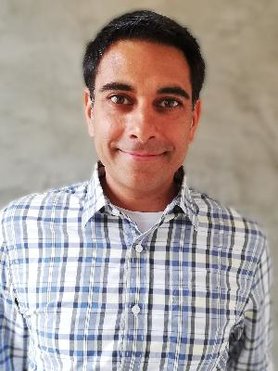

A. (Ajay) Seth
A. (Ajay) Seth
Profile
Biography
I lead the
Computational Biomechanics Lab in the department of Biomechanical Engineering here at TU Delft. The lab's mission is to develop computational models and algorithms that enable the acquisition, analysis and study of human and animal movement. We are interested in methods that quantify and explain the biological basis of movement from the pathological to the exceptional.
Before joining TU Delft, I was the architect of the
OpenSim modeling and simulation libraries at Stanford University for nearly a decade after completing a Simbios distinguished postdoctoral fellowship in Bioengineering. I received my PhD at the University of Texas at Austin in Biomedical engineering and my predoctoral degrees in Systems Design Engineering from the University of Waterloo.
Expertise
I build neuromuscular and musculoskeletal models and develop simulation tools to obtain deeper insights into human and animal movement. I combine expertise in multibody dynamics, muscle-tendon mechanics, neuromotor control and anatomy to create insightful and reproducible models. I leverage decades of software engineering experience to implement algorithms and simulators that enable new lines of research in movement science, assistive robotics and wearable sensing.
Publications
-
2024
Modeling of inflicted head injury by shaking trauma in children
what can we learn?: Update to parts I&II: A systematic review of animal, mathematical and physical models
Kim Hutchinson / Jan Peter van Zandwijk / Marloes E.M. Vester / Ajay Seth / Rob A.C. Bilo / Rick R. van Rijn / Arjo J. Loeve -
2023
Does enforcing glenohumeral joint stability matter?
A new rapid muscle redundancy solver highlights the importance of non-superficial shoulder muscles
I. Belli / S.D. Joshi / J.M. Prendergast / I.L.Y. Beck / C. Della Santina / L. Peternel / A. Seth -
2023
Human Modeling in Physical Human-Robot Interaction
A Brief Survey
Cheng Fang / Luka Peternel / Ajay Seth / Massimo Sartori / Katja Mombaur / Eiichi Yoshida -
2023
-
2023
Real-Time Tendon Strain Estimation of Rotator-Cuff Muscles during Robotic-Assisted Rehabilitation
I.L.Y. Beck / I. Belli / L. Peternel / A. Seth / J.M. Prendergast
-
Media
-
2018-07-26
Software recreates complex movements for medical, rehabilitation, and basic research
Appeared in: Phys.org
Prizes
-
2023-12-14
Finalist Best Interactive Paper Award at Humanoids 2023
For paper:
Beck, I., Belli, I., Peternel, L., Seth, A., & Prendergast, J. M, (2023, December). Real-time tendon strain estimation of rotator-cuff muscles during robotic-assisted rehabilitation. In 2023 IEEE-RAS 16th International Conference on Humanoid Robots (Humanoids). IEEE.
2023 IEEE-RAS 22nd International Conference on Humanoid Robots (Humanoids)
Ancillary activities
-
2022-11-18 - 2024-11-18
-
2022-11-18 - 2024-11-18